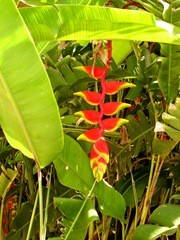 Every year, thousands of people vacation in Cancún and the beach resorts of the Riviera Maya without being aware of the natural and cultural treasures just a few hours away. Some take bus tours to the archeological ruins of Chichen Itza or Tulum, but even they may leave with the mistaken impression that the Mayan people and their world disappeared long ago.
Every year, thousands of people vacation in Cancún and the beach resorts of the Riviera Maya without being aware of the natural and cultural treasures just a few hours away. Some take bus tours to the archeological ruins of Chichen Itza or Tulum, but even they may leave with the mistaken impression that the Mayan people and their world disappeared long ago.
It’s true that much was lost after the fall of the great Mayan cities and the depredations of Spanish conquerors. But the Mayan people are still the primary inhabitants of Mexico’s Yucatán Peninsula. Many speak Yucatecan Mayan, practice traditional agriculture and craft techniques, and have an intimate knowledge of the Yucatán’s natural world.
And that natural world, though endangered, is rich and wonderful. Although from the tour-bus window the landscape may appear monotonous, the area actually offers a variety of complex and diverse ecosystems. It is a world-class destination for birders and plant-lovers.
But isn’t it dangerous? No. Many Americans mistakenly believe that most of Mexico is dangerous to visit. They are wrong. Although travelers should exercise normal precautions anywhere, the Yucatán is safe to visit. Areas dangerous for tourists are thousands of miles away.
A number of ecotourism companies offer day trips and longer tours to those wishing to explore natural and historical sites beyond the big resorts. And it’s not difficult to travel by rental car or public bus, staying at small hotels where staff can offer information about local sights.
This year, we travelled to the Yucatán village of Ek Balam, two hours west of Cancún. We stayed at Genesis Eco-Oasis,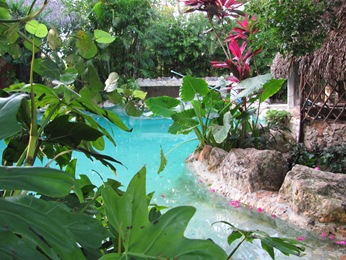 a small hotel founded by Canadian writer Lee Christie to enable visitors to learn about life in a Mayan town and villagers to earn some income. The village is a few kilometers from a major archeological site also named Ek Balam, and just a half hour north of the colonial city of Valladolid. It is centrally located between the ruins of Chichen Itza, the flamingo sanctuary at Rio Lagartos, and several other interesting destinations. Lee runs Genesis with the help of Pedro, whom she first met when she taught him English as a young man. Today Pedro has a wife and children, and is assistant manager of Genesis.
a small hotel founded by Canadian writer Lee Christie to enable visitors to learn about life in a Mayan town and villagers to earn some income. The village is a few kilometers from a major archeological site also named Ek Balam, and just a half hour north of the colonial city of Valladolid. It is centrally located between the ruins of Chichen Itza, the flamingo sanctuary at Rio Lagartos, and several other interesting destinations. Lee runs Genesis with the help of Pedro, whom she first met when she taught him English as a young man. Today Pedro has a wife and children, and is assistant manager of Genesis.
Genesis is built around a shady one-acre garden with a natural swimming pool at its heart. A large thatch-roofed sitting area,which also serves as a dining room and library, adjoins the garden, as do all the guest rooms. It’s easy to spend hours just sitting by the garden, reading, dipping into the pool, and chatting with Lee and hotel guests.
 The morning after our arrival, we drove from the village to see the ruins. The ancient site of Ek Balam was at the height of its power between 600 and 900 AD. While not as impressive as Chichen Itza, it’s a lovely place to visit, especially before 10 AM or after 3 PM when few other tourists are around. Nearby woodlands spill into the area, creating a sun-dappled park. We clambered over the Oval Palace and ambled across the grounds to climb the largest pyramid, know as the Acropolis. Halfway up the Acropolis is a recently uncovered plaster façade, designed to look like a gaping mouth decorated with geometric and human figures. It resembles something from an Indiana Jones movie. Descending from the Acropolis, we wandered down wooded paths where we saw an iguana perched on a rock and tropical birds, including a long-tailed turquoise motmot and several blue-and-yellow trogons.
The morning after our arrival, we drove from the village to see the ruins. The ancient site of Ek Balam was at the height of its power between 600 and 900 AD. While not as impressive as Chichen Itza, it’s a lovely place to visit, especially before 10 AM or after 3 PM when few other tourists are around. Nearby woodlands spill into the area, creating a sun-dappled park. We clambered over the Oval Palace and ambled across the grounds to climb the largest pyramid, know as the Acropolis. Halfway up the Acropolis is a recently uncovered plaster façade, designed to look like a gaping mouth decorated with geometric and human figures. It resembles something from an Indiana Jones movie. Descending from the Acropolis, we wandered down wooded paths where we saw an iguana perched on a rock and tropical birds, including a long-tailed turquoise motmot and several blue-and-yellow trogons.
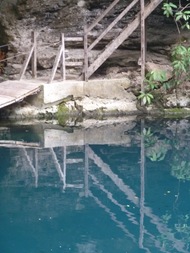 After seeing the ruins, we headed through the woods to the Xchanché cenote. As defined by Wikipedia, a cenote is “a deep natural pit, or sinkhole, characteristic of Mexico, resulting from the collapse of limestone bedrock that exposes groundwater underneath.” Some cenotes extend into large chains of caverns. The fresh water in cenotes is extremely important to local people because the peninsula lacks surface rivers. Cenotes also make enchanting swimming holes. Xcanché is being developed as a tourist destination by a local cooperative. Unfortunately, few tourists make the half-hour walk through the woods and cornfields to reach it. We were glad we did, though. Once we arrived, a caretaker guided us to the steep wooden stairway built into the side of the huge hole. The cenote was shaded by tall trees surrounding its rim. Birds skimmed the air overhead. Once at the bottom, we slipped into the cool azure water. Floating languidly, we gazed up and saw that the trees far above had stretched their roots from the rim down into the water. The rest of the world seemed far away. The small fee for entrance to this tranquil forest retreat helps support environmental conservation and local employment.
After seeing the ruins, we headed through the woods to the Xchanché cenote. As defined by Wikipedia, a cenote is “a deep natural pit, or sinkhole, characteristic of Mexico, resulting from the collapse of limestone bedrock that exposes groundwater underneath.” Some cenotes extend into large chains of caverns. The fresh water in cenotes is extremely important to local people because the peninsula lacks surface rivers. Cenotes also make enchanting swimming holes. Xcanché is being developed as a tourist destination by a local cooperative. Unfortunately, few tourists make the half-hour walk through the woods and cornfields to reach it. We were glad we did, though. Once we arrived, a caretaker guided us to the steep wooden stairway built into the side of the huge hole. The cenote was shaded by tall trees surrounding its rim. Birds skimmed the air overhead. Once at the bottom, we slipped into the cool azure water. Floating languidly, we gazed up and saw that the trees far above had stretched their roots from the rim down into the water. The rest of the world seemed far away. The small fee for entrance to this tranquil forest retreat helps support environmental conservation and local employment.
The next day we set out with Lee to meet local craftswomen. The village, composed mostly of small houses surrounded by dirt yards, is built on the site of an abandoned hacienda. People often sit in front of their homes surrounded by children, chickens, turkeys, and lots of dogs. The poverty is apparent. But there is much more to the Mayan village that meets the eye. And the houses and yards are themselves complex ecosystems that provide food and other necessities.
Our first stop was in front of a traditional oval Mayan house roofed with palm thatch. Lee explained that in the Yucatán’s suffocating summer heat, traditional houses admit more air and are cooler and less humid than modern cinder block houses. They also resist the Yucatán’s frequent hurricanes much better because the thatched roofs rise and fall with the wind. Even families who build modern houses often keep traditional houses nearby for use in the summer.
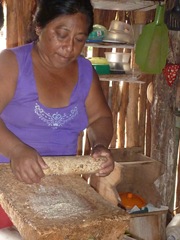 Our next stop was at the home of Doña Guadalupe, who showed us how to make corn tortillas and cook them over a wood fire. She patiently assisted our clumsy efforts, explaining that a large family can consume 200 tortillas at day. Life is easier now that a day’s supply of corn flour can be ground at the mill in the village center instead of on a stone metate. The mill has become a social gathering place for local women.
Our next stop was at the home of Doña Guadalupe, who showed us how to make corn tortillas and cook them over a wood fire. She patiently assisted our clumsy efforts, explaining that a large family can consume 200 tortillas at day. Life is easier now that a day’s supply of corn flour can be ground at the mill in the village center instead of on a stone metate. The mill has become a social gathering place for local women.
Next, we visited the home of Doña Tomasa, a hammock weaver. She follows traditional Yucatecan designs, but for outdoor hammocks she weaves with soft nylon fiber because it lasts longer than the traditional cotton. She also embroiders, practicing a craft which has brought income to village women for a long time. Though she uses a foot-powered sewing machine to create designs, her embroidery is still a highly-skilled craft, requiring an artistic eye and incredible hand-eye-machine coordination. We left with one of her colorful blouses and a blue-and-green hammock. Purchasing direct enables travelers to get better quality and be sure the entire proceeds go to the maker.
We were also fascinated to see the gardening methods used in the village. Growing food here is difficult, so methods have been developed over the centuries to deal with the challenges.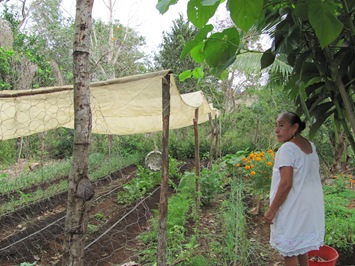 Because the Yucatán is a massive limestone shelf with limited topsoil and water, women practice container gardening . They grow vegetables such as onions and herbs in raised wooden trays and culinary and medicinal herbs in pots. Varieties of fruit trees surrounding homes may include citrus, papaya, coconut, tamarind, guava, and banana. Ramon trees provide fodder for livestock, and gourd trees provide bowls. Villagers also raise turkeys (Mexico’s only native poultry), chickens, and pigs. Corn, beans, squash and other vegetables are grown outside the village in traditional “milpa” fields which are used for a few seasons and then abandoned to regain their fertility while new fields are cleared.
Because the Yucatán is a massive limestone shelf with limited topsoil and water, women practice container gardening . They grow vegetables such as onions and herbs in raised wooden trays and culinary and medicinal herbs in pots. Varieties of fruit trees surrounding homes may include citrus, papaya, coconut, tamarind, guava, and banana. Ramon trees provide fodder for livestock, and gourd trees provide bowls. Villagers also raise turkeys (Mexico’s only native poultry), chickens, and pigs. Corn, beans, squash and other vegetables are grown outside the village in traditional “milpa” fields which are used for a few seasons and then abandoned to regain their fertility while new fields are cleared.
Lee explained that in Ek Balam, new gardening methods are being tried out, too. We visited Doña Felipe, who grows carrots, cabbage, onions, and herbs in rows of compost under shade cloth. A modern drip irrigation system delivers water exactly where it is needed. Gardeners learned the new methods from a government environmental agency which held training sessions in the village.
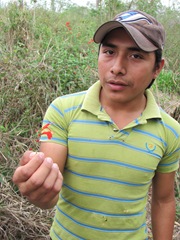 One morning, knowing that I am a botany buff, Lee asked a young employee to show us wild native plants. Modesto, a remarkable 17-year-old, first learned about local plants from his father. He became so interested that he took a training course from a reforestation agency. Modesto showed us wild plants that Mayans have relied on for a myriad of purposes over the centuries. The magnificent ceiba or yaxche tree, regarded by Mayans as the “world tree,” yields large green fruits filled with kapok fiber. At the mouth of a cenote used by villagers to water livestock, Modesto pointed out hule trees. Rubber from the hule was used by ancient Mayans to make balls for sacred games. Modesto explained that oaxe trees, like ramon trees, provide livestock forage. He showed us the chaca, whose bark is used to treat fungal diseases, and the yellow-flowered chacabal, whose fruits are eaten with salt and chile. He explained that branches of the pich’i are used to trap the mole-like tusa, whose meat is very healthy because it feeds on medicinal roots. But perhaps the most important plant Modesto showed us was the tajonal, whose bright yellow flowers are a favorite food of the native Yucatecan melipona bees. These stingless bees, now endangered, provide a nutritious honey which is an important part of the Mayan diet and brings income to villagers. Before we left the area, Modesto showed us several tropical birds, including one lovely species that he called the “hut-hut.”
One morning, knowing that I am a botany buff, Lee asked a young employee to show us wild native plants. Modesto, a remarkable 17-year-old, first learned about local plants from his father. He became so interested that he took a training course from a reforestation agency. Modesto showed us wild plants that Mayans have relied on for a myriad of purposes over the centuries. The magnificent ceiba or yaxche tree, regarded by Mayans as the “world tree,” yields large green fruits filled with kapok fiber. At the mouth of a cenote used by villagers to water livestock, Modesto pointed out hule trees. Rubber from the hule was used by ancient Mayans to make balls for sacred games. Modesto explained that oaxe trees, like ramon trees, provide livestock forage. He showed us the chaca, whose bark is used to treat fungal diseases, and the yellow-flowered chacabal, whose fruits are eaten with salt and chile. He explained that branches of the pich’i are used to trap the mole-like tusa, whose meat is very healthy because it feeds on medicinal roots. But perhaps the most important plant Modesto showed us was the tajonal, whose bright yellow flowers are a favorite food of the native Yucatecan melipona bees. These stingless bees, now endangered, provide a nutritious honey which is an important part of the Mayan diet and brings income to villagers. Before we left the area, Modesto showed us several tropical birds, including one lovely species that he called the “hut-hut.”
The plant walk with Modesto was a delightful demonstration of the natural knowledge many rural Mexicans grow up with. (We’ve also met people with terrific medicinal plant knowledge in the Mexican state of Oaxaca.) When Modesto turns 18, he’ll be eligible for certification as a nature guide. He wants to teach Yucatecan children to value the natural environment.
Modesto represents a source of hope. Many younger villagers are losing the knowledge that their ancestors acquired over millennia. Poverty and the lure of modern consumerism create a push-pull effect on local youth, and they often devalue traditional knowledge. Many migrate to find work in the factories of the Mérida area, the resorts of Cancún and the Caribbean coast, and the U.S. So in many villages, it is primarily the elderly who know how to work with the natural environment. Their rich agricultural, environmental, culinary, craft, and spiritual traditions, as well as the Yucatecan Mayan language itself, are in danger.
Their environmental wisdom is needed more than ever. The Yucatán’s diverse ecosystems are in peril. Megaresorts threaten water supplies and coastal ecosystems, including precious mangroves and coral reefs. Cattle ranching, agrochemicals, and monocropping eliminate habitat for wild plants and animals, deplete aquifers, and drive traditional farmers out of business. Clearcutting decimates previously diverse forest areas. Shortening of the fallow periods needed to regenerate milpa corn fields depletes the soil. As everywhere, climate change looms as a huge threat.
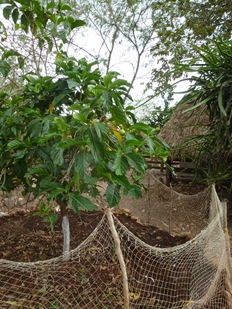 In addition to running Genesis, Lee has embarked on a new project, an organic farm she calls Regenesis. Drawing on both new and traditional practices, she hopes to showcase sustainable permaculture techniques appropriate to the area. With the help of local workers, she is growing fruit trees, vegetables, and livestock. Farm buildings are constructed from local materials, such as limestone-based aggregate. Livestock, including zebu cattle, donkeys, and poultry, eat materials grown on the farm. A fishpond is being excavated from the pockmarked limestone.
In addition to running Genesis, Lee has embarked on a new project, an organic farm she calls Regenesis. Drawing on both new and traditional practices, she hopes to showcase sustainable permaculture techniques appropriate to the area. With the help of local workers, she is growing fruit trees, vegetables, and livestock. Farm buildings are constructed from local materials, such as limestone-based aggregate. Livestock, including zebu cattle, donkeys, and poultry, eat materials grown on the farm. A fishpond is being excavated from the pockmarked limestone.
The farm faces many problems, everything from leafcutter ants to ducks that won’t lay. But the biggest challenge appears to be water. Near Ek Balam, we were troubled to see commercial cattle farms practicing water-intensive overhead irrigation of pastures with water from the precious aquifer. By contrast, Lee is experimenting with water-saving methods. For example, she surrounds her fruit trees with circular drip irrigation systems made out of recycled soft drink bottles and plastic tubing. Burying old water-soaked phone books around the trees helps to preserve ground moisture. Vegetable crops take advantage of the shade cast by the trees. But drought is a constant enemy, and Lee struggles to keep her young trees alive. It takes determination to find the right methods. The farm is a fascinating experiment in mixing Mayan and modern techniques to farm sustainably.
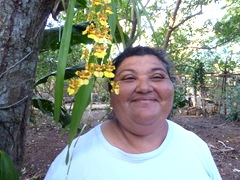 Ek Balam is within driving distance of several natural and historic sites. We sampled a few, including an orchid nursery in the small village of Solferino. One of the owners showed us delicate native orchids growing on slabs of wood in open-air lattice houses. She explained that to preserve native varieties, the family grows orchids with cuttings from “mother plants” rather than taking them from wild areas. With technical help from an environmental agency, they also use an en vitro technique to start seedlings in a simple, on-site laboratory. This project is one of the many efforts that preserve the Yucatán environment and provide income to local people.
Ek Balam is within driving distance of several natural and historic sites. We sampled a few, including an orchid nursery in the small village of Solferino. One of the owners showed us delicate native orchids growing on slabs of wood in open-air lattice houses. She explained that to preserve native varieties, the family grows orchids with cuttings from “mother plants” rather than taking them from wild areas. With technical help from an environmental agency, they also use an en vitro technique to start seedlings in a simple, on-site laboratory. This project is one of the many efforts that preserve the Yucatán environment and provide income to local people.
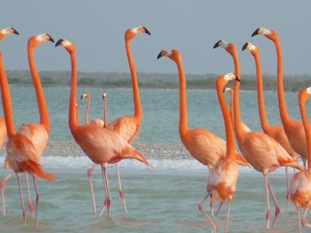 We also drove ninety minutes north of Ek Balam to the beautiful Ria Lagartos Biosphere Reserve. Home of Yucatán’s largest flamingo colony, the reserve can be toured by boat from the small coastal town of Rio Largartos. After a seafood lunch at the waterside “Restaurant Isla Contoy,” we went on a boat tour with a local guide. Juan took us miles up the mangrove-lined estuary. On the way, he showed us egrets, ibises, a pair of green and red parrots perched high in a dead tree, a wood stork, a tiger heron, great blue herons, black skimmers, and even a couple of crocodiles. We finally reached the flamingos feeding in shallow water. Profiled against the coastal salt flats, they were stunningly beautiful, with vivid coral and black plumage. With more time, we could have included swimming and a mud bath in our excursion.
We also drove ninety minutes north of Ek Balam to the beautiful Ria Lagartos Biosphere Reserve. Home of Yucatán’s largest flamingo colony, the reserve can be toured by boat from the small coastal town of Rio Largartos. After a seafood lunch at the waterside “Restaurant Isla Contoy,” we went on a boat tour with a local guide. Juan took us miles up the mangrove-lined estuary. On the way, he showed us egrets, ibises, a pair of green and red parrots perched high in a dead tree, a wood stork, a tiger heron, great blue herons, black skimmers, and even a couple of crocodiles. We finally reached the flamingos feeding in shallow water. Profiled against the coastal salt flats, they were stunningly beautiful, with vivid coral and black plumage. With more time, we could have included swimming and a mud bath in our excursion.
The Ria Lagartos Biosphere Reserve covers 150,000 acres, including wetlands, mangroves, forests, coastal dunes, lagoons, and marshes. It is considered a globally unique area and furnishes important breeding grounds for many bird species. Visiting the reserve helps support the economy and enables local people to remain in their communities rather than moving to Cancún or the U.S.
Our stay also included a drive to the small city of Valladolid, where we had dinner beside the central plaza and visited the local crafts market. We also drove to Tizimin, where we ate traditional Mayan dishes at the family-owned Tres Reyes restaurant.
We hope to return to learn more about the cultural and natural heritage of the Mayan Yucatán. It’s a world apart from Cancún, but infinitely more complex and wonderful. It’s a safe area with friendly people, fantastic natural areas, nice hotels, and great food.
Destinations and logistics
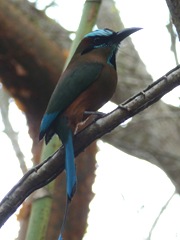 There are several ways to explore the lesser-known areas of the Yucatán. Ecotourism agencies offer nature-oriented day trips to destinations such as Isla Contoy north of Cancún, the Sian Ka’an Biosphere Reserve south of Tulum, and the Ria Lagartos Biosphere Reserve.
There are several ways to explore the lesser-known areas of the Yucatán. Ecotourism agencies offer nature-oriented day trips to destinations such as Isla Contoy north of Cancún, the Sian Ka’an Biosphere Reserve south of Tulum, and the Ria Lagartos Biosphere Reserve.
Before you go, be sure to check out the reputation of your tour operator. Some are truly dedicated to protecting the Yucatán’s environment and sustaining local communities. Others have few local ties and are more party–oriented. Just because a company advertises ecotourism doesn’t mean its commitment is genuine.
If you can spend more than a day away from Cancún and the Riviera Maya, it’s relatively easy to travel by rental car and stay at a hotel. Most people go to the ruins Chichen Itza on a day trip, but you can see more if you stay overnight. Genesis Retreat and the community-run Najil Ek Balam Eco-Cabañas in Ek Balam, as well as the hotels of Valladolid, are less than an hour’s drive away. Lodging is also available very close to the ruins of Chichen Itza in the town of Piste. Staying overnight allows you to visit the ruins in the early morning, when it’s cool and the tour buses still haven’t arrived. The high-end but beautiful Hacienda Chichen, near the ruins, offers birding and other nature tours.
Further west, the colonial city of Mérida is a great destination, with its museums, dance, music, cafes, and craft stores. Best of all are the colorful street fairs every Sunday. Mérida is five hours west of Cancún and makes a great base for exploring the natural and archeological sites of the western Yucatán. If you don’t want to rent a car, you can take a first-class bus from Cancún and book local day trips in Merida.
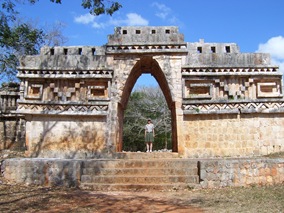 Ninety minutes south of Mérida lies the Puuc region, home of the magnificent Uxmal archeological site as well as other fascinating places. There are nice hotels near the ruins, but we like the Flycatcher Inn in nearby Santa Elena, where owners Kristine and Santiago are wonderful hosts. Nearby at the U Yits Ka’an School of Ecological Agriculture , Mayan farmers learn about natural fertilizers, worm composting, natural pest management, medicinal plants, and cultural traditions. Though not generally open for tours, the school is an important effort to encourage sustainable farming and protect the Yucatán environment.
Ninety minutes south of Mérida lies the Puuc region, home of the magnificent Uxmal archeological site as well as other fascinating places. There are nice hotels near the ruins, but we like the Flycatcher Inn in nearby Santa Elena, where owners Kristine and Santiago are wonderful hosts. Nearby at the U Yits Ka’an School of Ecological Agriculture , Mayan farmers learn about natural fertilizers, worm composting, natural pest management, medicinal plants, and cultural traditions. Though not generally open for tours, the school is an important effort to encourage sustainable farming and protect the Yucatán environment.
If you’re interested in all-inclusive tours from the U.S., consider participating in birding and nature tours sponsored by groups like the Audubon Society.
Other ideas? Google away! There’s plenty of information on interesting destinations. The website http://yucatanwildlife.com/ is a good place to start.
On your next trip, see some of the real Yucatán and meet the people who are working to preserve its culture and natural environment. You will discover a complex, wonderful area.
